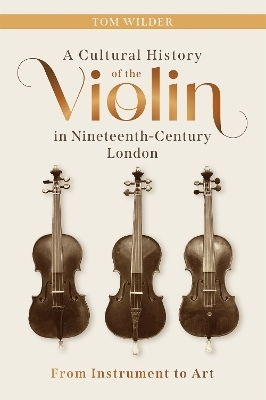
A Cultural History of the Violin in Nineteenth-Century London
From Instrument to Art
Seiten
2025
Boydell & Brewer (Verlag)
978-1-83765-258-7 (ISBN)
Boydell & Brewer (Verlag)
978-1-83765-258-7 (ISBN)
- Noch nicht erschienen (ca. März 2025)
- Versandkostenfrei innerhalb Deutschlands
- Auch auf Rechnung
- Verfügbarkeit in der Filiale vor Ort prüfen
- Artikel merken
Examines the violin's evolution as not just instrument but valued objet d'art through the eyes of musicians, collectors, makers, dealers, connoisseurs, journalists, auctioneers and traders.
The nineteenth century saw developments in the composition, performance and reception of classical music that led to an unprecedented shift in how the violin was appreciated, from humble craft object to one of art. A utilitarian tool defined in 1800 by its tonal properties became by century's end an expensive objet d'art, classified almost exclusively in terms of physical, visible properties. In London's vibrant musical life, Cremonese violins acquired special significance and in turn helped shape the beliefs, knowledge and behaviour of the disparate actors connected to the instrument: musicians, collectors, makers, dealers, connoisseurs, journalists, auctioneers and traders.
By 1880, London had supplanted Paris as the centre of the international violin trade. One firm in particular, W.E. Hill & Sons, emerged as a major presence in both the local musical community and the global violin market. The Hills were makers, restorers, dealers, and connoisseurs. They were also writers, collectors, and melomaniacs deeply implicated in London's instrument auction and exhibition scene. The mutually reinforcing nature of these activities - which they consciously turned to account for commercial reasons - bear witness to events and developments earlier in the century. Their story illuminates this first study of the violin's nineteenth-century journey from simple musical instrument to mystified work of art.
The nineteenth century saw developments in the composition, performance and reception of classical music that led to an unprecedented shift in how the violin was appreciated, from humble craft object to one of art. A utilitarian tool defined in 1800 by its tonal properties became by century's end an expensive objet d'art, classified almost exclusively in terms of physical, visible properties. In London's vibrant musical life, Cremonese violins acquired special significance and in turn helped shape the beliefs, knowledge and behaviour of the disparate actors connected to the instrument: musicians, collectors, makers, dealers, connoisseurs, journalists, auctioneers and traders.
By 1880, London had supplanted Paris as the centre of the international violin trade. One firm in particular, W.E. Hill & Sons, emerged as a major presence in both the local musical community and the global violin market. The Hills were makers, restorers, dealers, and connoisseurs. They were also writers, collectors, and melomaniacs deeply implicated in London's instrument auction and exhibition scene. The mutually reinforcing nature of these activities - which they consciously turned to account for commercial reasons - bear witness to events and developments earlier in the century. Their story illuminates this first study of the violin's nineteenth-century journey from simple musical instrument to mystified work of art.
TOM WILDER attended the Chicago School of Violin Making and apprenticed as an instrument restorer in Seoul, Los Angeles and Paris. He is founder of Wilder & Davis Luthiers Inc. in Montreal, a past president of the American Federation of Violin and Bow Makers, and holds a PhD from the University of Cambridge.
List of Illustrations
Acknowledgements
Introduction
1. The Emerging Canon of Musical Instruments
2. The Violin at Work
3. The Musical Press: Mirror and Catalyst
4. Collections: Public Display, Private Gatherings
5. Working on the Violin
6. Commerce
7. Connoisseurship and Connoisseurs
8. Synthesis: W. E. Hill & Sons
Conclusion
Bibliography
| Erscheint lt. Verlag | 18.3.2025 |
|---|---|
| Vorwort | James Ehnes |
| Zusatzinfo | 37 b/w illus. |
| Verlagsort | Woodbridge |
| Sprache | englisch |
| Maße | 156 x 234 mm |
| Themenwelt | Kunst / Musik / Theater ► Musik ► Instrumentenkunde |
| Kunst / Musik / Theater ► Musik ► Klassik / Oper / Musical | |
| Geisteswissenschaften ► Geschichte ► Regional- / Ländergeschichte | |
| ISBN-10 | 1-83765-258-9 / 1837652589 |
| ISBN-13 | 978-1-83765-258-7 / 9781837652587 |
| Zustand | Neuware |
| Informationen gemäß Produktsicherheitsverordnung (GPSR) | |
| Haben Sie eine Frage zum Produkt? |
Mehr entdecken
aus dem Bereich
aus dem Bereich
Buch | Softcover (2024)
Edition Zwischentöne (Verlag)
19,00 €
Roman
Buch | Hardcover (2024)
Wallstein Erfolgstitel - Belletristik und Sachbuch (Verlag)
20,00 €


